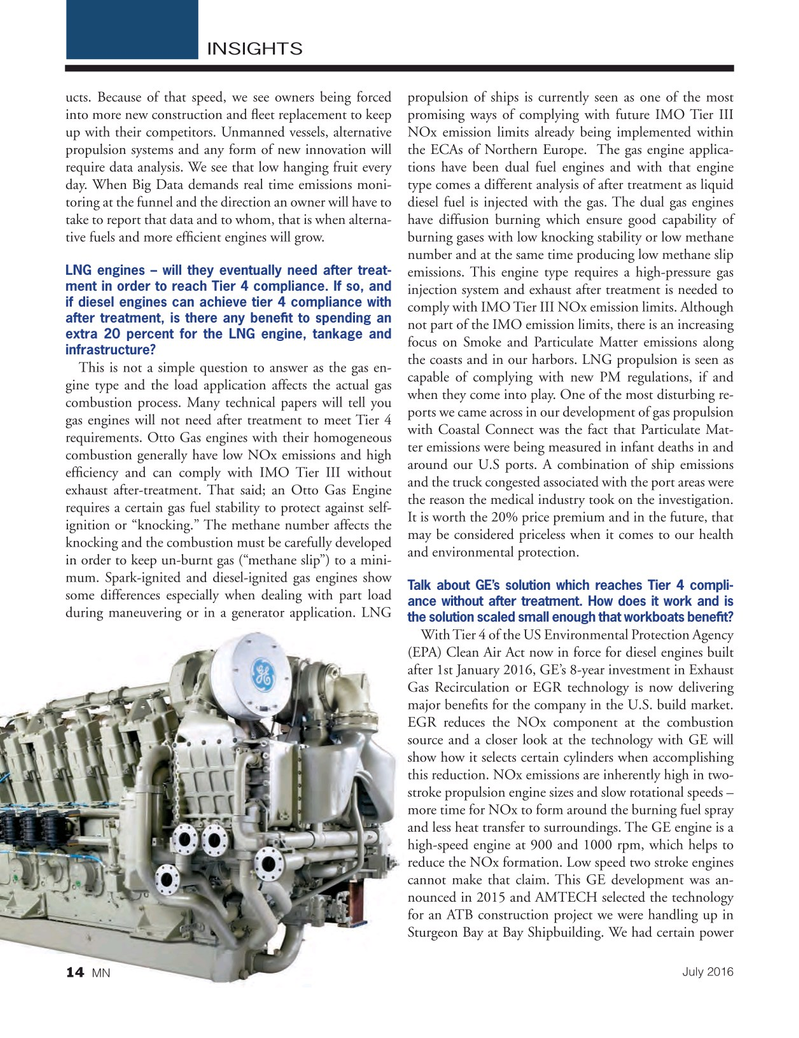
Page 14: of Marine News Magazine (July 2016)
Propulsion Technology
Read this page in Pdf, Flash or Html5 edition of July 2016 Marine News Magazine
INSIGHTS ucts. Because of that speed, we see owners being forced propulsion of ships is currently seen as one of the most into more new construction and ? eet replacement to keep promising ways of complying with future IMO Tier III up with their competitors. Unmanned vessels, alternative NOx emission limits already being implemented within propulsion systems and any form of new innovation will the ECAs of Northern Europe. The gas engine applica- require data analysis. We see that low hanging fruit every tions have been dual fuel engines and with that engine day. When Big Data demands real time emissions moni- type comes a different analysis of after treatment as liquid toring at the funnel and the direction an owner will have to diesel fuel is injected with the gas. The dual gas engines take to report that data and to whom, that is when alterna- have diffusion burning which ensure good capability of tive fuels and more ef? cient engines will grow. burning gases with low knocking stability or low methane number and at the same time producing low methane slip
LNG engines – will they eventually need after treat- emissions. This engine type requires a high-pressure gas ment in order to reach Tier 4 compliance. If so, and injection system and exhaust after treatment is needed to if diesel engines can achieve tier 4 compliance with comply with IMO Tier III NOx emission limits. Although after treatment, is there any bene? t to spending an not part of the IMO emission limits, there is an increasing extra 20 percent for the LNG engine, tankage and focus on Smoke and Particulate Matter emissions along infrastructure?
the coasts and in our harbors. LNG propulsion is seen as
This is not a simple question to answer as the gas en- gine type and the load application affects the actual gas capable of complying with new PM regulations, if and combustion process. Many technical papers will tell you when they come into play. One of the most disturbing re- gas engines will not need after treatment to meet Tier 4 ports we came across in our development of gas propulsion requirements. Otto Gas engines with their homogeneous with Coastal Connect was the fact that Particulate Mat- combustion generally have low NOx emissions and high ter emissions were being measured in infant deaths in and ef? ciency and can comply with IMO Tier III without around our U.S ports. A combination of ship emissions exhaust after-treatment. That said; an Otto Gas Engine and the truck congested associated with the port areas were the reason the medical industry took on the investigation. requires a certain gas fuel stability to protect against self- ignition or “knocking.” The methane number affects the It is worth the 20% price premium and in the future, that may be considered priceless when it comes to our health knocking and the combustion must be carefully developed and environmental protection.
in order to keep un-burnt gas (“methane slip”) to a mini- mum. Spark-ignited and diesel-ignited gas engines show
Talk about GE’s solution which reaches Tier 4 compli- some differences especially when dealing with part load ance without after treatment. How does it work and is during maneuvering or in a generator application. LNG the solution scaled small enough that workboats bene? t?
With Tier 4 of the US Environmental Protection Agency (EPA) Clean Air Act now in force for diesel engines built after 1st January 2016, GE’s 8-year investment in Exhaust
Gas Recirculation or EGR technology is now delivering major bene? ts for the company in the U.S. build market.
EGR reduces the NOx component at the combustion source and a closer look at the technology with GE will show how it selects certain cylinders when accomplishing this reduction. NOx emissions are inherently high in two- stroke propulsion engine sizes and slow rotational speeds – more time for NOx to form around the burning fuel spray and less heat transfer to surroundings. The GE engine is a high-speed engine at 900 and 1000 rpm, which helps to reduce the NOx formation. Low speed two stroke engines cannot make that claim. This GE development was an- nounced in 2015 and AMTECH selected the technology for an ATB construction project we were handling up in
Sturgeon Bay at Bay Shipbuilding. We had certain power
July 2016 14 MN
MN July16 Layout 1-17.indd 14 6/20/2016 3:21:00 PM

 13
13

 15
15
